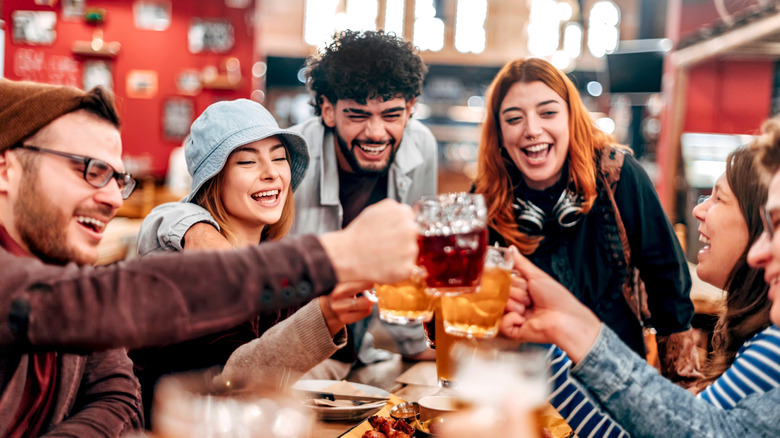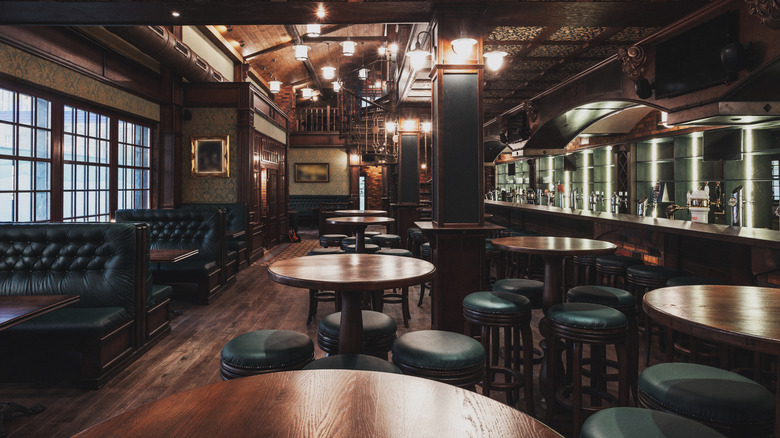What Does A Wet Pub Mean, And How Is It Different From A Brew Pub?
Much as Irish pubs have their own rules of etiquette, so do the Brits. And while this certainly encompasses the dos and don'ts, it also includes Britain's unique pub naming conventions. And just like North Americans have sports bars, cocktail bars, and dive bars, British drinkers also have their pick of choices, such as gin palaces, freehouses, and gastro pubs (like this local favorite hidden beneath one of London's most iconic landmarks). Then there are also two classic options: the wet pub and the brew pub.
Though the term wet pub may conjure visions of patrons getting sprayed playfully with soda guns by bartenders dancing above them, "Coyote Ugly"-style, the actual meaning is far more tame. It's simply a bar that doesn't serve food, meaning all of its offerings are "wet" — just drinks. You may be able to purchase a packet of crisps or bar nuts if you're lucky, but the focus of such an establishment is on creating an environment where it's easy to mingle. Not being belly-up with food orders means that a wet pub can offer a wider selection of drinks, encouraging an even more jovial atmosphere. Traditionally, these venues have been a benchmark for building community within British culture.
A brew pub or brewery tap, on the other hand, is about more than just drinking ale. It offers the chance to drink beer right where it's being made — the brewery's own on-premise customer-facing operation. The setup typically displays tanks where drinks are made, implying that this will be the freshest sip you'll ever get. The focus at a brew pub is on beer (with perhaps a side of cider and kombucha), but it will typically offer full meals as well. And while there may be a guest tap, the selection will be limited to the brewery's own output.
Other types of British pubs
Don't go thinking your options are limited to wet pubs and brew pubs alone in the U.K. There's a pub for every type of drinker on the British Isles — even travel expert Rick Steves has a favorite pub scene in all of London. In his eyes, a historic tavern (in particular, the Angelsea Arms in South Kensington) "is everything a British pub should be" (via Rick Steves' Europe). The building dates back to 1712, and from within, the dark wood bartop glows in the light of brassy lamps while musty paintings hang atop Victorian panel walls. Then the gin palace is like the tavern's flashy younger cousin. Birthed in the 19th-century heyday of cheap gin, these watering holes feature gaudy gas lamps, etched glass mirrors, ornate mouldings, and no seating whatsoever — making them the wettest of the wet bar set.
For customers who seek pubs with the best beer, beyond brew pubs there are craft beer pubs, where the focus is on variety and quality of taps, and you're likely to see any big name brands like Newcastle or Stella Artois; brewery chain pubs, which unlike brew pubs, do not actually brew onsite and typically focus on their parent brand's brews (Greene King and Marston's being prime examples); freehouses, which are independent operations free of contracted obligations to wholesalers that pour highly curated selections; and micropubs, barebones beer-swilling operations that might not fit more than 20 people within. Other types of specialty pubs include gastro pubs, which are essentially restaurants within a pub setting; sports pubs, where patrons can watch the game on TV; and flat-roofed pubs, dingy-looking relics of the post-war housing boom.

